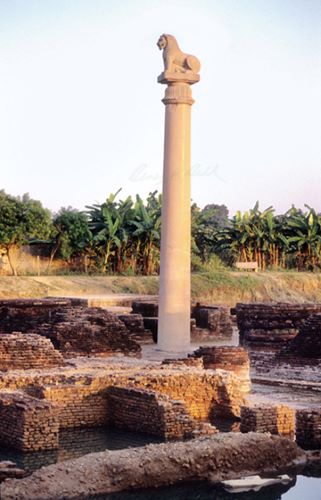Early Indian tradition focused on the eternal themes, not human personalities

Ashoka Pillar, Vaishali, third century BCE. Photo credit: Benoy K Behl.
Benoy K Behl
A most remarkable Indian tradition of the early period is that the focus of life and society was on the eternal themes and not on human personalities, which were, after all, ephemeral. In the 3rd century BCE, even the rulers did not inscribe their names upon their messages on monuments. Almost all inscriptions of the rulers of that time are in the name of Devanam Piya Piyadassi, literally, ‘one who is beloved of the divine and whose vision is filled with adoration’. This Indic tradition was, at that time, also being followed by the king of Sri Lanka who used the same title. In fact, when the Indian inscriptions were first translated, these were ascribed by historians to the Sri Lankan king, as his inscriptions were already known through translation. Later, they were ascribed to Ashoka. A king of that period, to the north-west of India, also used the same title translated into Aramaic (the language in which Jesus Christ was to speak a few centuries later).
The art of the Mauryan period has yielded some of the most enduring and easily recognisable symbols of Indian art. One of these is the lion capital of the pillar at Sarnath. Now preserved in the site museum at Sarnath, the capital has four lions placed back-to-back, facing the cardinal directions, indicating the spread of dharma everywhere. The animals are made in a formal and stylised manner and are reminiscent of the Persian tradition. The lions originally supported a large chakra or wheel. Chakras are also made on the circular drum under the paws of the lions. The chakra is an important symbol of cosmic order in Upanishadic thought. In Buddhism, it represents the turning of the ‘Wheel of Law’ or dharma. Four animals are also made proceeding clockwise around the drum, suggesting the movement of the wheel of dharma. Unlike the lions above, these animals are made in a highly naturalistic manner, with an emphasis on their movement and musculature. This continues the sensitivity towards animal life which is seen from the Indus Valley period.
Ashoka and his grandson Dasratha made rock-cut caves at Barabar, near Gaya in present-day Bihar. These were made for the Ajivikas, a deeply ascetic sect of that time. With these caves at Barabar began one of the greatest architectural traditions in India. Hundreds of rock-cut caves were later made for the Buddhist, Jaina and Hindu traditions.
The Mauryan period brings us finely sculpted figures, which establish the traditions to come in later times. A two-feet high nude male figure may represent a follower of the Digambar sect of Jainas, who renounce clothing. It may be remembered here that Chandragupta Maurya gave up his throne in his later years to become a Jaina ascetic. The artist’s mastery over stone is seen in the naturalism and sensitivity in modelling. The hard stone has been transformed into pliant flesh. There are many similarities between this figure and a tiny male torso made during the Indus Valley period.
One of the best-known Maurya period sculptures is that of a female chauri or whisk bearer. It was found at Didarganj, in present-day Patna. The figure is approximately life-sized and is practically free-standing. The high-polish of the sandstone here is considered a hallmark of Mauryan stone sculpture. She is shown wearing a translucent lower garment and heavy ornaments. The lower garment, bare torso and jewellery remain a norm in sculptures of later periods. In the Mauryan period, the formal, frontal posture and the monumentality of the figure serve to create a certain distance between the viewer and the sculpture.
Centralised royal workshops would probably have been set up, as is indicated by a uniformity of style and material. There appears to have been a preference for the tan coloured sandstone which was quarried from Chunar, near modern-day Patna.

